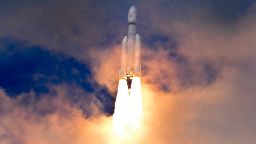A Russian spacecraft malfunctioned over the weekend, sending the vehicle crashing into the moon. The failed landing attempt has experts questioning the future of the country’s lunar exploration ambitions and the geopolitical dynamics that underpin modern space exploration efforts.
The spacecraft, Luna 25, lost contact with operators at Russia’s space agency, Roscosmos, on Saturday, August 19. By Sunday, the vehicle was declared dead.
Initial reports from the head of Roscosmos, Yury Borisov, indicate there was a problem with the vehicle’s engines, causing it to misfire as it attempted to adjust its orbit in the days before landing.
The failure was a major blow to the space agency’s ambitions. Russia had been seeking to prove that its civil space program, which analysts say has faced issues for decades, can still achieve the stunning feats it showcased during the 20th-century space race.
“Russia’s Cold War legacy will be just that — a legacy — unless they can actually do this themselves,” said Victoria Samson, the Washington office director for Secure World Foundation, a nonprofit that promotes the peaceful exploration of outer space.
Under the former Soviet Union, Russia managed to safely land seven spacecraft on the lunar surface, including the first-ever soft landing in 1966.
Borisov acknowledged that the Soviet successes of last century weren’t easily repeatable.
“We have to essentially master all the technologies all over again — of course, at a new technical level,” he said during an interview with Russian state media on Monday.
Borisov has offered assurance that Roscosmos can get back on track. He said the space agency will accelerate its next two moon missions: Luna 26 and Luna 27, which could give Roscosmos all the science it lost with the failure of Luna 25.
Still, space policy experts question whether the Russian government has the power or the will to make that happen, particularly as the country faces sanctions around the war in Ukraine and Roscosmos appears to be of diminishing importance to the Kremlin.
“Even if they said they were going to continue (the Luna program), that doesn’t necessarily mean anything at this point. And the question is: Can they continue? Do they have the capability to continue it?” said Robert Pearson, a former ambassador to Turkey, former director general of the U.S. Foreign Service, and a founding member of Duke University’s Space Diplomacy Lab.
The consequence of this failure, Pearson added, is that on the global stage, it raises the question of whether Russia is “seriously in the space race” at all.
A changing civil space landscape
Russia’s failed moon landing attempt comes amid a rush of other lunar exploration efforts, largely designed by countries that haven’t been seen as traditional space powers. Luna 25 was flying alongside India’s Chandrayaan-3 spacecraft, which will attempt to land on the moon as soon as Wednesday.
More than a dozen other countries also have plans for moon missions in the coming years, including the United States’ ambitious Artemis III, which could land astronauts on the lunar surface as soon as 2025.
“I think it … speaks to how much the cost of space exploration has dropped,” Samson said. “It’s still not cheap by any stretch of the imagination, but it’s gotten a little more reasonable. … I think that’s why more countries are able to (attempt) it.”
But while the loss of Luna 25 may widely be seen as a setback for Russia’s space ambitions, it’s worth noting that putting a spacecraft on the moon remains an exceedingly difficult feat.
India’s last attempt, with the Chandrayaan-2 spacecraft, failed. And two other commercial spacecraft have also crash-landed since 2019.
Perhaps different expectations were placed on Russia, however, because of its extensive Soviet-era experience.


Comments
Post a Comment